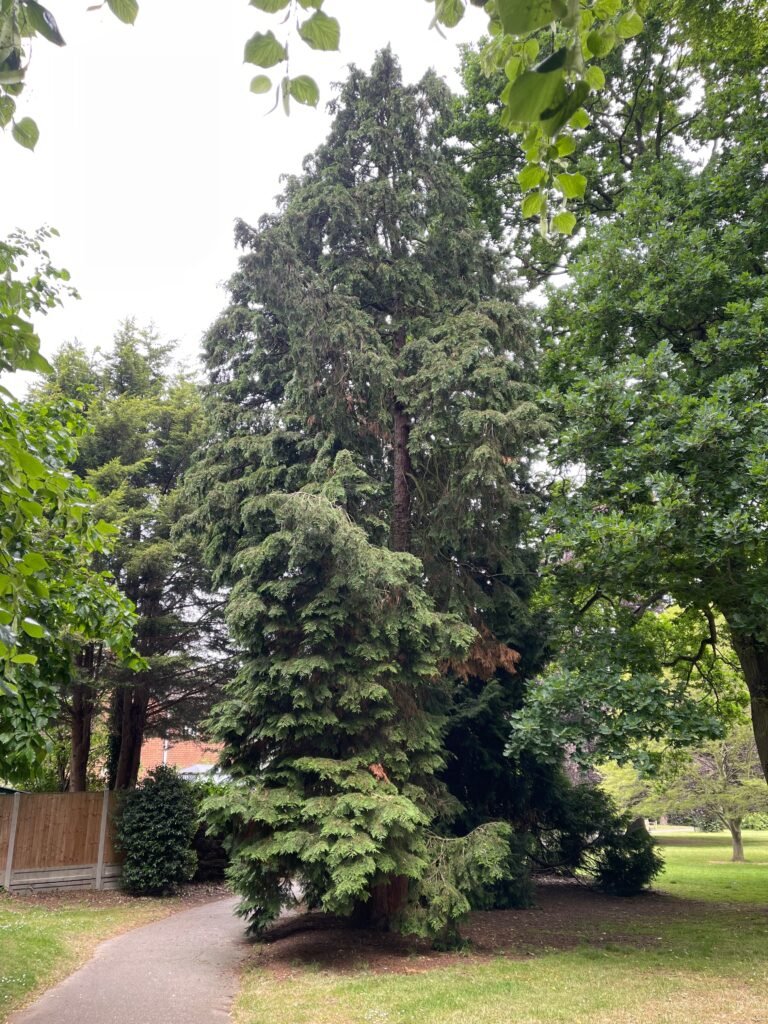Cypress, Lawson
The Lawson Cypress, is an evergreen conifer, that can grow to a height of 45m high, and may live more than 500 years.
A tall, narrowly conical tree, with feathery foliage. The bark is cracked into vertical plates, and the twigs are a dark bluish-grey.

Photo supplied by: Alan Payne
Common Name:
Lawson Cypress
Scentific Name:
Chamaecyparis lawsoniana
Tree No:
179
Location:
D4

Short scale-like leaves are grouped in fours and hide the twigs, forming flat planes. They are closely pressed together, producing flat sprays of foliage. They are green with a whitish tinge underneath. The foliage has a pungent scent, rather like parsley.

Credit: Alan Payne
Minute flowers, which look like buds, open at the twig tips in spring. Male flowers are crimson, becoming yellow with pollen, and females are blue.

Credit: This could be your image
Cones ripen from female flowers, starting green, then turning cream and finally ending brown. They are pea-sized with broad scales.

Credit: This could be your image
Lawson cypress is native to California and was introduced to Britain in 1854. There are now many ornamental cultivars. This evergreen tree is grown widely in parks, gardens and churchyards. It can regenerate from seed, and has naturalised on banks, walls and woodland margins throughout lowland UK. It grows best in moist but not waterlogged soils.
The dense foliage provides shelter for nesting birds, including various finches, when many broadleaved trees are still in bud.
The wood, which is strong and light, is highly valued in Japan for coffin and shrine construction. It is also used to make arrow shafts and musical instruments, especially guitars. It is grown widely in the UK as an ornamental tree.
Here is a good opportunity to tell the difference between the Lawson Cypress (Tree 179) and Western Red Cedar growing alongside it (Tree 180)
There are several Lawson Cypress as well as Western Red Cedars in the gardens see if you can tell them apart. Look at the cones. The Lawson Cypress cones open around a central point. On the underside of the foliage, they have a series of white crosses.
On the other side of the path close to the gate into St Peter’s Road from the right is a Cypress Macrocarpa Tree (Tree 173). This is a true Cypress not to be confused with the Lawson Cypress of which there are many in the gardens.
.
Tree Listings
Mulberry
Page Title Overview text Diffent points following a single enter.Photo supplied by:Common Name:Xxx Scentific Name:Xxx Tree No:00 Location:X0Content to follow. Credit: This could be your image Content to follow. Credit: This could be your image...
Golden Irish Yew
Yew, Golden Irish The Golden Irish Yew, is an evergreen conifer, that can grow to a height of 7m, and may live for over 2,000 years, although 1,500 years may be more typical. The bark is brown-grey with purple tones, and it peels. This tree was planted for the...
Goat Willow
Willow, Goat The Goat Willow, also known as the pussy willow, is a broadleaved deciduous tree, that can grow to a height of 10m, and may live for 300 years. The bark is grey-brown and develops diamond-shaped fissures with age. Twigs are hairy at first but become...
Whitebeam
Whitebeam The Whitebeam, is a charming broadleaved deciduous tree, that can grow to a height of 15m, and may live for 200 years. They're compact and domed. The bark and twigs are grey, and the shoots are brick red in sunlight but greyish-green in shade. This tree was...
Black Walnut
Walnut, Black The Walnut, is a broadleaved deciduous tree, that can grow to a height of 35m, and may live for 200 years. They typically have a short trunk and broad crown, though can be narrower if grown in a woodland situation. The bark is smooth and olive-brown when...
Sycamore
Sycamore Tree The Sycamore Tree, is a large broadleaved deciduous tree, that can grow to a height of 35m, and may live for 400 years. The bark is dark pink-grey, and smooth when young, but becomes cracked and develops small plates with age. Twigs are pink-brown and...
Snowy Mespil
Snowy Mespil The Snowy Mespil, is small deciduous tree, that can grow to a height of 7m, and may live for 60 years. This tree was planted in 1995 By Mrs M. Pocock in memory of her husband. Photo supplied by: Alan PayneCommon Name:Snowy Mespil Scentific...
Rowan Tree
Rowan Tree The Rowan Tree, is an elegant broadleaved deciduous tree, that can grow to a height of 15m, and may live for 200 years. The bark is smooth and silvery grey, and leaf buds are purple and hairy. Photo supplied by: Alan PayneCommon Name:Rowan Tree...
Rowan Tree
Rowan Tree The Rowan Tree, is an elegant broadleaved deciduous tree, that can grow to a height of 15m, and may live for 200 years. The bark is smooth and silvery grey, and leaf buds are purple and hairy. Photo supplied by: Alan PayneCommon Name:Rowan Tree...
Wollemi Pine
Pine, Wollemi Content to follow. Photo supplied by: Alan PayneCommon Name:Wollemi Pine Scentific Name:Wollemia nobilis Tree No:190 Location:D7Content to follow. Credit: This could be your image Content to follow. Credit: This could be your image...
Scotch Pine
Pine, Scots The Scots Pine (UK), Scotch Pine (US), is a truly stunning evergreen conifer, that can grow to a height of 35m, and may live for 700 years. A tall straight pine tree. The scaly bark is istinctive orange-brown, which develops plates and fissures with age....
Red Oak
Oak, Red The Red Oak, is a fast growing broadleaved deciduous tree, that can grow to a height of 25m, and may live for 500 years, although 300 years may be more typical. The bark is smooth and silver-grey when young, and develops warts or ridges with age. Twigs are...
Braintree & Bocking Public Gardens,
43 Bocking End,
Braintree,
CM7 9AE.
Open 9:00 to 4:00pm – January, February.
Open 9:00 to 6:00pm – March.
Open 9:00 to 7:00pm – April.
Open 9:00 to 8:00pm – May, June, July, August.
Open 9:00 to 7:00pm – September.
Open 9:00 to 6:00pm – October.
Open 9:00 to 4:00pm – November December.
Note – The gates are locked at dusk.
Dusk is subject to seasonal variation, so closing times may not be exactly to the schedule, at the transitions.
No dogs allowed in the gardens.
No alcohol to be consumed in the gardens.
No riding of cycles or scooters in the gardens.
General Enquiries
Phone: 01376 773066
Email: info@braintreeandbockinggardens.co.uk
Tennis Enquiries
Phone: 01376 773070
Email: tennis@braintreeandbockinggardens.co.uk
© Braintree & Bocking Public Gardens Trust 2017-2021. All Rights Reserved.
Registered Charity Number 212989
Get in touch


Braintree and Bocking Public Gardens
We provide, maintain and preserve these unique and beautiful gardens as a community green space.